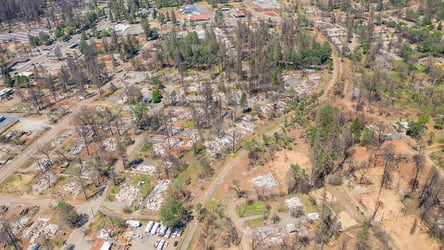Editor’s note: This article is the sixth installment in the 2025 Future of Risk series, which explores the rise of systemic risks — threats that are difficult to predict, span industries and carry the potential for widespread disruption. This piece examines parametric insurance and how it can help build resilience against these risks.
Climate volatility, natural disasters and supply chain disruptions create systemic risks — where the ripple effects of a single event stretch across industries and borders. Wildfires in Canada can idle U.S. factories. A drought in Argentina can have a ripple effect on global commodity markets. A hurricane can knock out local infrastructure and international trade routes.
Traditional insurance isn’t always efficient in this environment of extreme risk. Indemnity-based coverage requires lengthy claims processes, on-the-ground assessments and negotiations over coverage, sublimits and exclusions. When you’re facing business losses, that lag time can be debilitating.
Parametric insurance can help you build resilience against these risks.
What is parametric insurance?
Parametric insurance is an index-based coverage that pays out based on a predefined event or trigger, as opposed to traditional indemnity-based insurance policies. Instead of waiting for an adjuster to measure the actual damage, the policy is connected to objective data points like maximum wind speeds during a hurricane, total rainfall during a drought or seismic readings during an earthquake. If the agreed-upon threshold is triggered, the payout is made automatically, typically within a few days.
Key benefits of parametric insurance
While parametric insurance has gained broader attention recently, it is not a new concept; however, it is reshaping how you can prepare for and respond to economic disruption. Here are a few reasons why parametric insurance plays a pivotal role in the future of risk management:
Faster claim payout response
When disaster strikes, timing is everything. Traditional insurance claims can sometimes take months. Parametric policies, by contrast, can pay out within days because they depend on objective data rather than on-site inspections. That speed allows you to deploy capital immediately, whether to restart operations, protect employees or stabilize cash flow.
Defined triggers for predictable recovery
Because parametric policies link payouts to predefined parameters, there is less ambiguity. You know in advance what triggers coverage and what the payout will be. This reduces disputes and builds confidence in risk planning.
Strategic risk mitigation for systemic events
Systemic risks span multiple industries and geographies and can be expensive or challenging to insure through traditional means. Parametric insurance addresses this issue by tying coverage to specific events, such as hurricanes, earthquakes, droughts or supply chain disruptions. It injects liquidity when and where it’s needed most.
Multi-industry flexibility
Although parametric products gained traction in property insurance, diverse industries are now recognizing their utility. Each faces systemic risks that traditional insurance may struggle to address efficiently on its own.
How parametric insurance delivers results across industries
Parametric insurance is already helping businesses prepare for, withstand and recover from disruption. Here are a few examples:
- Agriculture: Farmers use weather indexes like rainfall thresholds to hedge against drought or frost. A cooperative that experiences rainfall below a preset level during the planting season automatically receives funds, enabling them to quickly invest in irrigation or cover crop losses.
- Energy: Solar and wind projects depend on weather stability. A solar farm with a parametric policy tied to radiation levels can receive payouts if sunlight falls below a certain threshold, stabilizing revenue despite unpredictable weather.
- Construction and real estate: Developers rely on project timelines. A hurricane that delays construction milestones can prompt a parametric payout based on wind speeds recorded by meteorological stations, providing immediate liquidity to help keep projects on track.
- Art and cultural institutions: Museums and galleries can use parametric policies to protect collections from floods, fires or other natural events, with payouts initiated by objective data like rainfall gauges or water levels. For example, a historic museum in Venice implemented coverage tied to flood sensors, ensuring immediate funds to safeguard priceless artworks without bureaucratic delays.
- Oil and gas: Offshore platforms in storm-prone seas use parametric triggers tied to wave heights and wind speeds. Rapid payouts allow operators to suspend operations safely and repair infrastructure without prolonged downtime.
- Hospitality: Resorts in hurricane zones rely on parametric coverage that activates when wind speeds surpass defined levels. Rapid funding enables hotels to conduct emergency repairs, safeguard guests and reopen more quickly.
Across industries, parametric coverage provides organizations with a predictable safety net when disruptions occur.
Integrating parametric and traditional insurance programs
Parametric insurance isn’t a replacement for traditional policies; it’s a companion.
Let’s say a business purchases a parametric policy activated by a Category 3 hurricane to cover cash flow needs and holds a traditional property policy to cover specific damage. If the hurricane strikes but causes minimal property damage, the parametric policy still pays out, providing crucial liquidity even when traditional coverage doesn’t apply.
This dual-layered approach builds resilience.
Building a proactive framework for emerging risks
Parametric insurance represents a turning point in how organizations can manage risk in the years ahead. By shifting the focus from damage assessment to objective, data-driven triggers, it introduces a level of speed, transparency and flexibility that traditional models can’t match. As climate volatility, natural disasters and supply chain disruptions continue to intensify, parametric insurance is gaining momentum.




